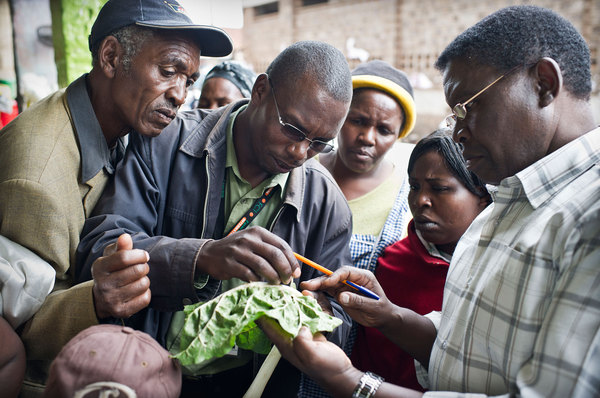Plantwise initiative helping improve food security in Zambia
Ever since Lackson Njovu, a farmer in Rufunsa district, learnt how to deal with plant diseases and pests using the natural way, his harvest has improved. Mr Njovu now registers less losses and feeds more by identifying, preventing and curing plant health problems. On his five hectares farm east of the capital, Lusaka, where he…
Plantwise Bangladesh in a new era of partnership: National Extension Officers trained as Plant Doctors
The Plantwise programme in Bangladesh was launched with the training for module 1 (Field Diagnosis and Plant Clinic Operation) and module 2 (Introduction to Plant Healthcare) for 32 extension officers in Dhaka early this March. The training followed the signing of a tripartite agreement between the Economic relation division, Ministry of Agriculture and CABI on…
Perú: Una visita al campo con los Doctores de Plantas en Huamanga-Ayacucho
Texto escribido por los doctores de planta de la Estación Experimental Agraria Canaán (INIA): Victoriano Eduardo Núñez Cuba, Melancio Huamani García y Aníbal N. Huarancca, y editando por Léna Durocher-Granger (CABI-UK). English summary follows El Instituto Nacional de Innovación Agraria (INIA), organismo público adscrito al Ministerio de Agricultura y Riego, a través de la Estación Experimental…
Plant clinics help improve yields in Machakos, Kenya
“Approximately 300 farmer-self help groups from Machakos County and its environs under the Katoloni community-based organization have registered improved crop yields in the last one year due to high levels of sensitization on crop pest and diseases at plant clinics in the region,” writes Maugo Owiti of HiviSasa.com. In the article, Pius Ndaka, a farmer…
Factsheet of the month: March 2015 – Tomato yellow leaf curl management
A recent plant protection conference in Hanoi highlighted dangerous levels of pesticide use in agriculture in Vietnam. The head of Vietnam’s Plant Protection Department, Nguyen Xuan Hong, announced that a 5-year Integrated Pest Management (IPM) project had been approved by the Ministry of Agriculture and Rural Development. IPM will be important in reducing both costs to…
Plant clinics helped improve my yield
I meet Rose Wanjiru Ireri in her 2.5 acre farm in Mbeere inspecting her crops. From the smile on her face, it is apparent that her plants are healthy. “I grow oranges, mangoes, cassava and vegetables on my farm. I also produce a lot of bananas for sale.” She currently has over 100 banana plants…
Perú: Dos nuevas clínicas de plantas para los agricultores Lambayecanos
Autores: Martha Passador (CABI) y Juan Pablo Gonzáles (EEA Vista Florida) English summary follows Debido a las necesidades de asistencia en algunos puntos más lejanos de la región de Lambayeque en Perú, y mediante dos nuevos módulos de asistencia técnica, en el cual las Clínicas de Plantas forman parte del componente de diagnóstico y recomendación…
Factsheet of the month: February 2015 – Sugarcane Woolly Aphids
India is one of the world’s largest producers of sugarcane which is used in many food and drink products. Sugarcane is vulnerable to a variety of pests, including sugarcane woolly aphids which caused a 30% yield loss in the outbreak of 2002. This pest is constrained to south and east Asia, (see the Plantwise distribution…
Factsheet of the month: January 2015 – Management of clubroot disease in crucifers
Clubroot is a serious disease of crucifers. It is found in many countries across the world (see the Plantwise distribution map). It is caused by the fungus Plasmodiophora brassicae, whose spores can live for many years in the soil. This makes the disease difficult to control once a field has been infected. To find out more about…


